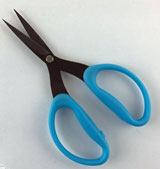- Home
- Free Quilt Block Patterns
- Morning Quilt Block
Morning Quilt Block Pattern
From our Free Quilt Block Patterns Library
This post contains affiliate links, for which I receive compensation.
Skill Level: Beginner
Our Morning quilt block combines both traditional and paper piecing techniques for perfectly pointy points.
If you can sew on a line, you can make this block.
There's ALWAYS more than one way to get things done in quilting!
If you'd prefer to skip the paperpiecing altogether, check out the Weathervane quilt block. Same basic design—just no paperpiecing!
Rise and shine! Morning has broken.
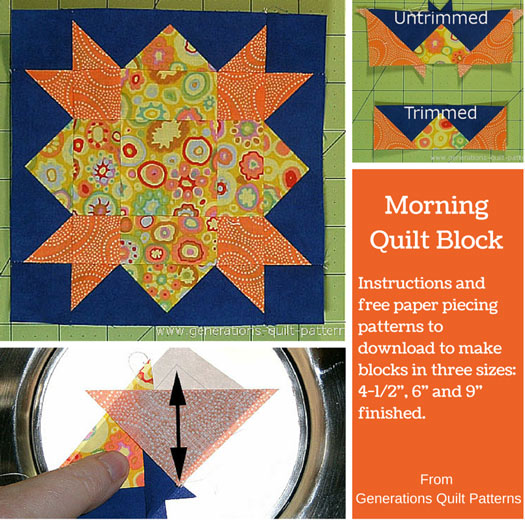
📋 General Instructions
I switch between two different presser feet—an open toe applique foot and my favorite quarter inch foot with a guide—as each is best for its particular job.
I prefer to use heavily starched quilt fabric. My cuts are more precise; my stitching more accurate.
And for paperpiecing, it's 'da bomb' because you can fingerpress so many of your seams instead of jumping up and down to the iron.
A great time saver and no sacrifice in quality!
Step 1: Download/print the patterns
You'll need Adobe Reader installed on your computer in order to open and print the Morning quilt block pattern. You can get it here (a new window opens so you can download it without leaving this page).
Open the downloaded file, and select the "Print" option.
To insure the patterns print at the correct size, under 'Page Sizing and
Handling' in the Adobe print menu, set 'Custom Scale' to 100%. Click here to see what it looks like on the Print Menu page.
If you use something other than Adobe, you'll need to set 'Page Scaling' to 'None'. Selecting 'Actual Size' tends to render blocks at weird sizes. ( I don't know why, it just does. )
After printing one block, measure it to see that it is correct before making any remaining copies.
Choose your 'Finished Block Size' from the table below. Use the corresponding link for as many paper patterns as you need for your personal use.
| PRINT the Paper Piecing Patterns | ||
|---|---|---|
| Finished Block Size | # of copies to print | Link to PDF Pattern |
| 4-1/2” | 1 | 4-1/2" |
| 6” | 1 | 6" |
| 9” | 1 | 9" |
Cut out each of the four units just outside the dashed line that surrounds it. No need to be particularly neat here. Everything is trimmed to perfection at the end!
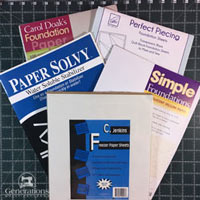
Not sure which paper to use?
Take a look at my review of several of the most popular brands available to us quilters on the market.
You want a super-easy paper to tear away—less stress on the stitches.
Step 2: Cutting patches for a Morning block
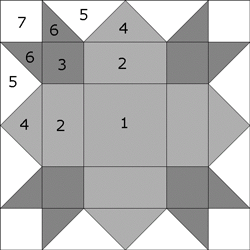 Morning patchwork pattern
Morning patchwork patternSample Size: 6" finished / 6½" unfinished
Grid: 6x6
Design Type: Even 9-patch
Like all quilt blocks, good contrast between the M(edium), D(ark) and background fabrics is essential for all the pieced parts to show up.
Don't forget to subcut patches #4-#6.
The yellow print used in this sample block is from Kaffe Fassett's 'Paperweights' collection. [Click here for more options.]
 |
Cutting Chart for a~ Paper Piecing ~ | |||||
|---|---|---|---|---|---|---|
| Patch | Fabric | Qty | Finished Block Size | Sub Cut | ||
| 4-1/2” | 6” | 9” | ||||
| 1 | M | 1 | 2”x2" | 2-1/2”sq | 3-1/2”sq | na |
| 2 | M | 4 | 1-1/4”x2” | 1-1/2”x2-1/2” | 2”x3-1/2” | na |
| 3 | D | 4 | 1-1/4”x1-1/4" | 1-1/2”sq | 2”sq | na |
| 4 | M | 1 | 3-1/8”x3-1/8" | 3-5/8”sq | 4-5/8”sq | |
| 5 | L | 2 | 3-1/8”x3-1/8" | 3-5/8”sq | 4-5/8”sq | |
| 6 | D | 4 | 2-1/8”x2-1/8" | 2-3/8”sq | 2-7/8”sq | |
| 7 | L | 4 | 1-1/4”x1-1/4" | 1-1/2”sq | 2”sq | na |
| Unfinished Block Size | 5” | 6-1/2” | 9-1/2” | na | ||
| Grid Size | 3/4" | 1" | 1 1/2" | na | ||
Step 3: Stitch the Morning quilt block units
Sides

Make 4
With a dot of Elmer's Gluestick, adhere the back of a #4 to the unprinted side of pattern. Use the dashed guidelines (arrows) to quickly and accurately position the patch.
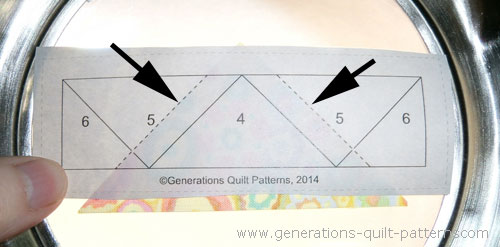
General Sewing Machine Setup for Paperpiecing
- Reduce your stitch length to 16–20 stitches per inch (1.3-1.6 mm). This perforates the paper and stabilizes the seam when you remove the pattern. [Learn more about stitch length here.]
- Reduce your machine's speed or just plain slow down. Sew only as fast as you can stay on the stitching lines.
- Install an open toe appliqué foot (sometimes called an 'embroidery' or 'satin stitch' foot) if you have one (it's easier to see where you're stitching with one installed).
- Use a larger needle (90/14) if you have problems removing the pattern.
- If your machine has a needle stop up, use it. The stitching goes faster when you don't have to lift the presser foot with every seam.
- As you stitch each seam, start and stop a generous 1/4” before and after the solid stitching lines. ALWAYS. Future lines of stitching secure the ends.
After adding each patch, press the unit as it was sewn to set the seam and then open. The SA is automatically pressed towards the last patch added.
Before adding the next patch, take a look to make sure the one you just added covers the space plus seam allowance that it is supposed to.
Steam is optional and usually curls the pattern.
If that bothers you, don't use steam. Sometimes I do. Sometimes I don't.
It truly depends on my mood.
Remember, as you follow this paper piecing tutorial, the printed and the fabric sides of this block are mirror-images of each other.
At last!
Let's sew!
With right sides together (RST) align a short edge of #5 to either the left or right side of #4. (It doesn't matter which side you start with.)
Position the patch so that the adjacent short side extends a scant 1/4" past the solid line between #5 and #6. (see the arrows below) This saves you the step of trimming the SA.
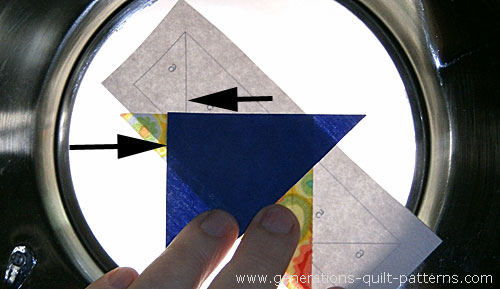 Take a second and flip the #5 patch back to make sure it is positioned correctly. Until you're used to piecing this side unit, it has a tendency to look a little backwards.
Take a second and flip the #5 patch back to make sure it is positioned correctly. Until you're used to piecing this side unit, it has a tendency to look a little backwards.Stitch on the line between #4 and #5, starting and stopping a 1/4" from this line.
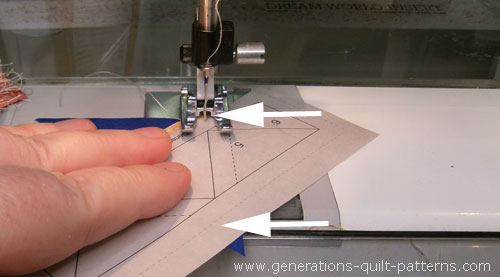 Stitch from arrow to arrow.
Stitch from arrow to arrow.Press.
Add the second #5 to the other side of the #4, pressing again.
If the #5 patches extend more than a 1/4" past the solid line between #5 and #6, trim the SA to 1/4".
With RST, position a #6 with the short edge of a #5. For easy placement, the point of the #6 should line up directly with the corner of #6 on the pattern.
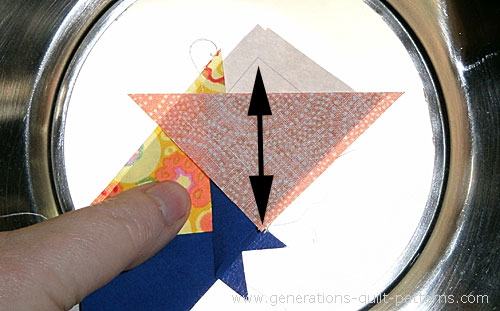 Don't forget to trim away those dog ears (yellow print) as you see them to reduce bulk.
Don't forget to trim away those dog ears (yellow print) as you see them to reduce bulk.After pressing, trim each of the side units to size. Lay the 1/4" mark of your rotary ruler on the solid outline of the block and trim. Repeat for each side of all four units.
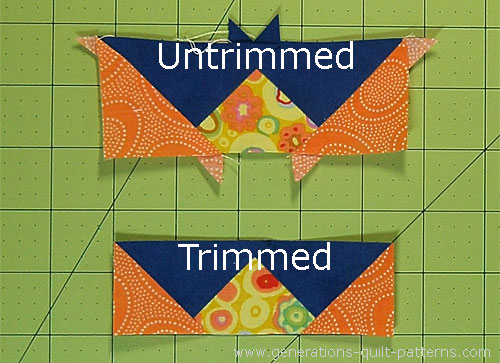
Remove the paper pattern.

The paper piecing is complete. From this point forward, return your stitch length to the one you regularly use for piecing and install your favorite 1/4" presser foot.
Center
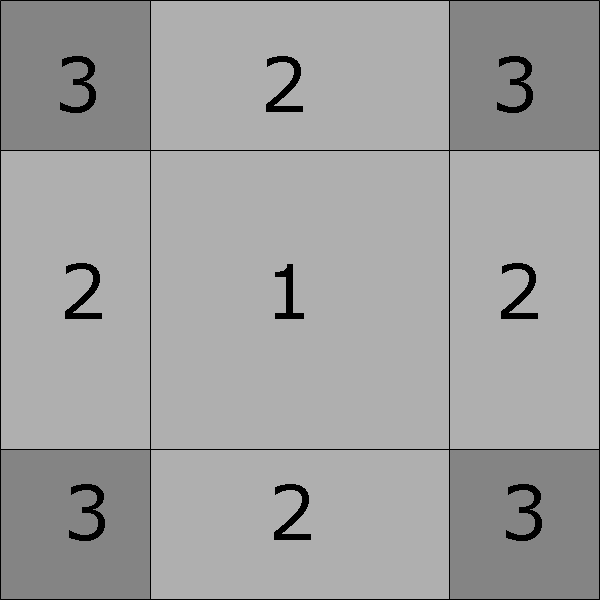
Make 1
With RST, stitch a #2 to opposite sides of #1.
Stitch a #3 to both short sides of the remaining two #2 rectangles. Press the SA away from the #2 rectangles.
After stitching, they look like this...
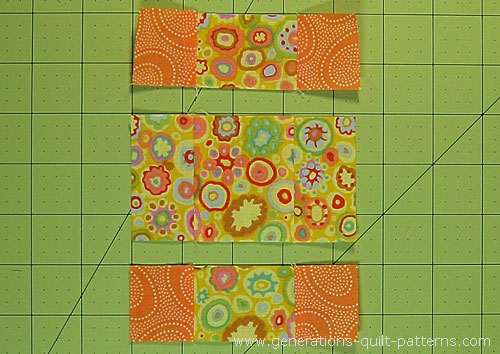
With RST stitch a #3/#2/#3 to each side of the #2/#1/#2 patch. Pin if needed.
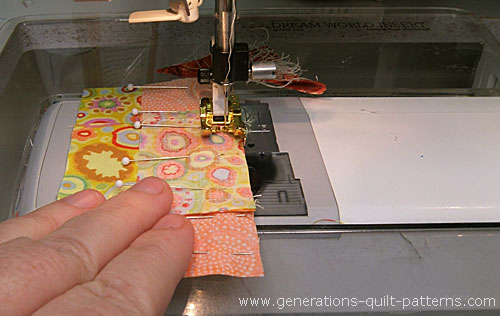 Yep! Pinning is in my blood.
Yep! Pinning is in my blood.Press these SA away from the center.
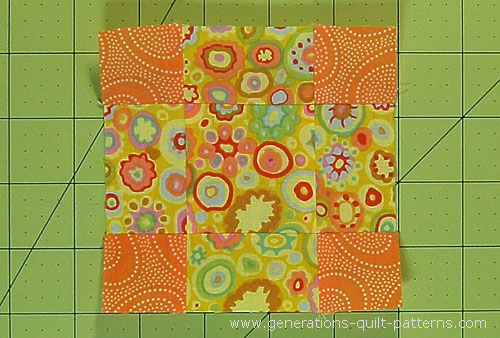
Step 4: Assemble your Morning quilt block
Arrange the cut and sewn units as shown below.
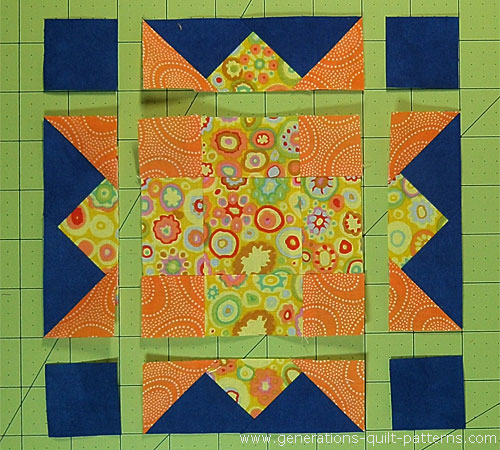
Stitch the units in each row together, pressing the SA away from all the side units to reduce bulk.
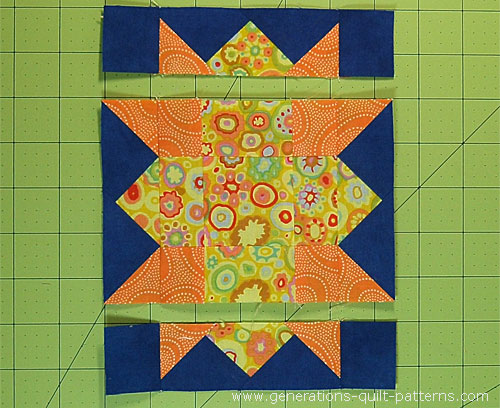
Stitch the rows together. I find it helpful to use pins to make sure the valleys of the side units meet the seam line between the #2 and #3 patches.
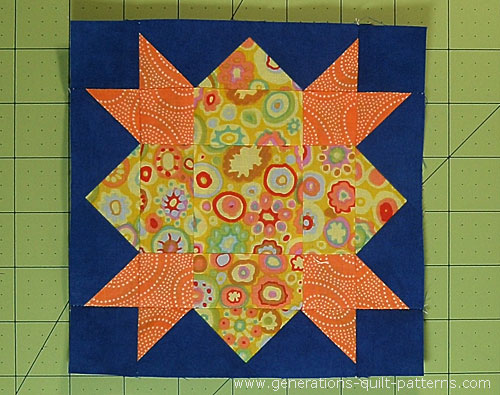 Our Morning block is ready for a quilt!
Our Morning block is ready for a quilt!Our Morning quilt block is finished!
Variation on the Morning patchwork design
The Weathervane quilt block is a close match to the Morning design, though the patches are quite different. The Weathervane is made from squares—not a triangle in sight.
If you prefer to skip the paper piecing, click here to go to those instructions.
What about a different quilt block?
For a list of all the 220+ quilt block patterns on this site, start here.
If you know the name of the block, shorten your search by using these links:
Click here if you're looking for blocks with at least some paper piecing.
Click here if you're looking for the basic building blocks of quilting, i.e., Flying Geese, half square triangles, quarter square triangles, etc., along with several techniques to make each.
And finally, use these links to find blocks in these finished sizes:













